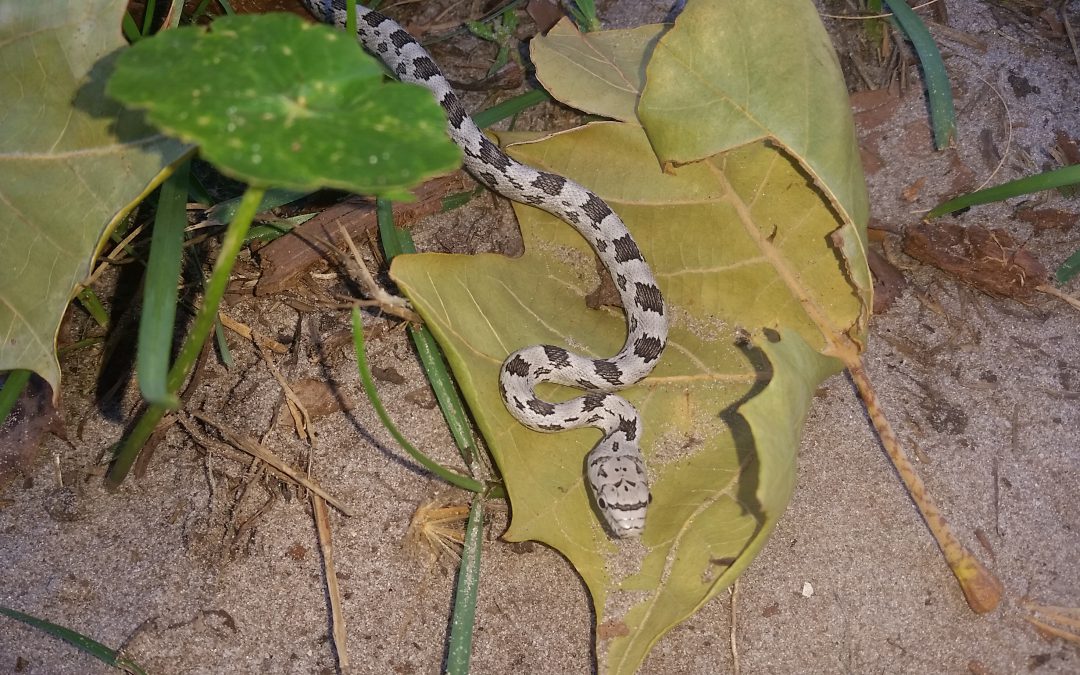
by Erik Lovestrand | Aug 27, 2021
It seems like there has always been a soft spot in my heart for snakes. From a young age, I was fascinated with all reptiles. The rural fabric of where I grew up in Central Florida (think late-1960s) afforded many opportunities for us kids to roam the woods and fields in search of adventure during summer vacation. I vividly remember the occasional eastern hognose snake that we would catch as kids. They were easy to house for a while, as there was no shortage of toads for a food source. This article will focus on some of the common species of snakes in NW Florida and a couple of snake safety tips.
Very likely, one of the first species of snakes most people encounter in North Florida is the gray rat snake (aka oak snake). If you raise chickens, you can greatly reduce the time it takes to enjoy your first encounter. I pull oak snakes out of our nest boxes on a regular basis. I have also encountered some rather large pine snakes in this manner; one with eight egg lumps in its mid-section. These are both harmless, beautiful creatures that can unfortunately make you hurt yourself in a dimly lit coop as you reach in to collect eggs. Another commonly encountered snake in our area is the corn snake, also called a red rat snake. The orange background and dark-red blotches make this one of our most beautiful species. Southern black racers are also a commonly seen species due to their daytime hunting habits. Racers are black on the back with a white chin and very slender for their length. They live up to their name and can disappear in a flash when startled. Two other species regularly encountered here are in the “garter snake” group. The eastern garter snake is one of very few species in our area with longitudinal stripes. They can have a tan to yellowish background color or even a greenish or blue color. The closely related ribbon snake looks similar in color and pattern but has a much slimmer build.

Gray rat snakes are also called oak snakes and are quite common in North Florida
My home county of Wakulla is home to four species of venomous snakes, which include the eastern diamondback rattlesnake, pygmy rattlesnake, coral snake and Florida cottonmouth. However, if you live in other parts of North Florida, you may have five or possibly even six species that are venomous. The copperhead’s range extends into North Florida in a few Counties along the Apalachicola River and the canebrake (or timber) rattlesnake ranges slightly farther south in the peninsula to North-Central Florida. I’ve only seen one canebrake rattlesnake and it was crossing a road on the north side of Gainesville many years ago. Both pygmy rattlers and cottonmouths can be very abundant locally in the right habitats but diamondbacks and coral snakes are less common these days having lost much of their preferred habitats to development.
My best advice for those worried about being bitten by a snake is don’t try to pick one up, and watch where you put your hands and feet. It really is relatively easy to avoid (key word here is avoid) being bitten by a snake. There are many good medical sites on the web with detailed recommendations for snakebite treatment. In the very rare circumstance when someone is envenomated, the best policy is to remain as calm as possible and head for medical attention. Do not cut the skin and try to suck out the venom or apply a tourniquet. These strategies generally cause more harm than good.
I always appreciate the chance to get a look at one of our incredible native snakes when afield, especially if it happens to be one of our venomous species. A big diamondback rattlesnake is an impressive animal to happen on when afield. This appreciation does not mean that I don’t get startled occasionally when surprised, but once that instinctive reaction passes, I can truly appreciate the beauty of these scaly critters.
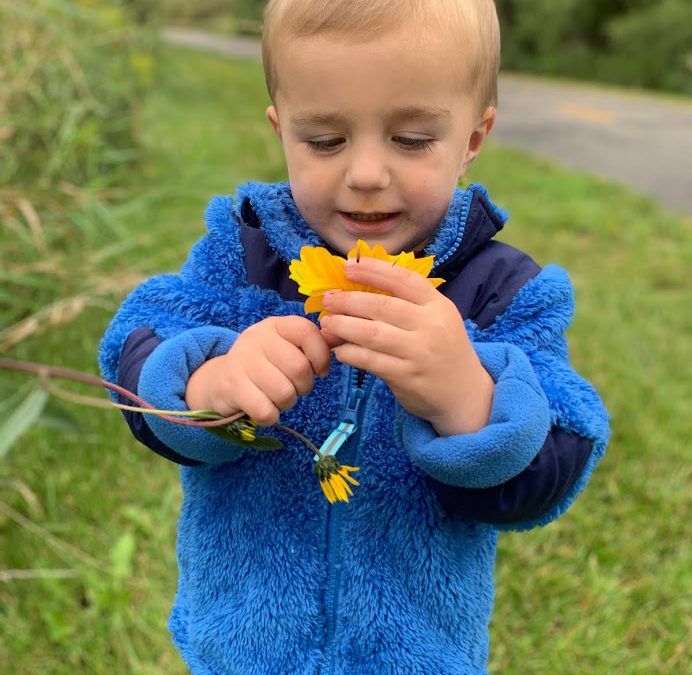
by Molly Jameson | Aug 12, 2021

Article by Rachel Mathes, Horticulture Program Assistant with UF/IFAS Extension Leon County.
By Rachel Mathes
My only brother and his family live in Appleton, Wisconsin. Though I’m only able to see my niece and nephews one or two times a year, we have a deep connection through our love of the outdoors.
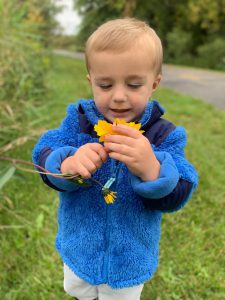
Zach discovering the joy of nature. Photo by Rachel Mathes.
Their middle son, Zachary, is a budding naturalist at just four years old. When I visit them, Zach, his brother Connor, sister Cecilia, and I, load up the wagon and go for walks on the edge of the prairie in their neighborhood. We start our walks looking for scat and signs of wildlife. Because the kids are so close to the ground, they often spot wildlife trails before I do. We talk about what animals may be there, what they eat, and how we can help them.
After each walk, we wind down at home with an iNaturalist session. Zach and his siblings help me choose what animal or plant we think we saw with the help of the app’s nearby suggestions tool. A favorite game we play after all our photos are entered into the app is a game we’ve coined, “where’s that animal?” We use the iNaturalist explore feature to find sightings of exciting creatures like wolves and beavers near their home. The kids have learned that even scientists often don’t see the animals they study, just signs of them.
At age three, Zach learned to identify milkweed with impressive accuracy. I pointed out the plant on a previous trip more than six months earlier and he remembered how to find them. Common milkweed, Asclepias syriaca, is a large leafed species that prefers winters a bit colder than we get here in the Florida Panhandle, but is native in northern states across the Eastern US, including Wisconsin. Zach is often stopping the wagon to scout for monarch caterpillars, finding even the smallest instars and eggs.
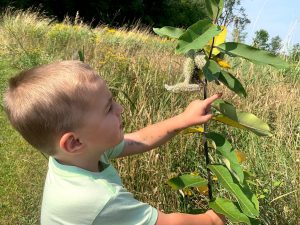
Zach learned to identify common milkweed, Asclepias syriaca, at the age of three. Photo by Rachel Mathes.
When I video call the kids from Florida, Zach is often asking to see my fruit trees, vines, and bushes. He knows that we have very different seasons than Wisconsin when I am eating blueberries in May and he’s still knocking frost off his snow boots. In July, he tells me about the raspberries they find in the woods with their dad. We both get a bit of seasonal berry jealousy. On my last trip we planted thornless blackberries in their garden together. It remains to be seen whether the birds will let the kids have a harvest, but the kids will be excited either way.
Though we may live a thousand miles apart, I know my relationship with my niece and nephews will continue to thrive as they explore the natural world around them. One day, I hope to introduce them to the awe of Florida manatees and alligators. Until then, I will relish the time we get to spend together outdoors in nature and on the phone together. I know that Zachary and his siblings will grow up having respect for the natural world and I hope he always exclaims, “Monarch! Look auntie Rachel, a monarch caterpillar!” on our walks together.
Author: Rachel Mathes, Horticulture Program Assistant with UF/IFAS Extension Leon County.
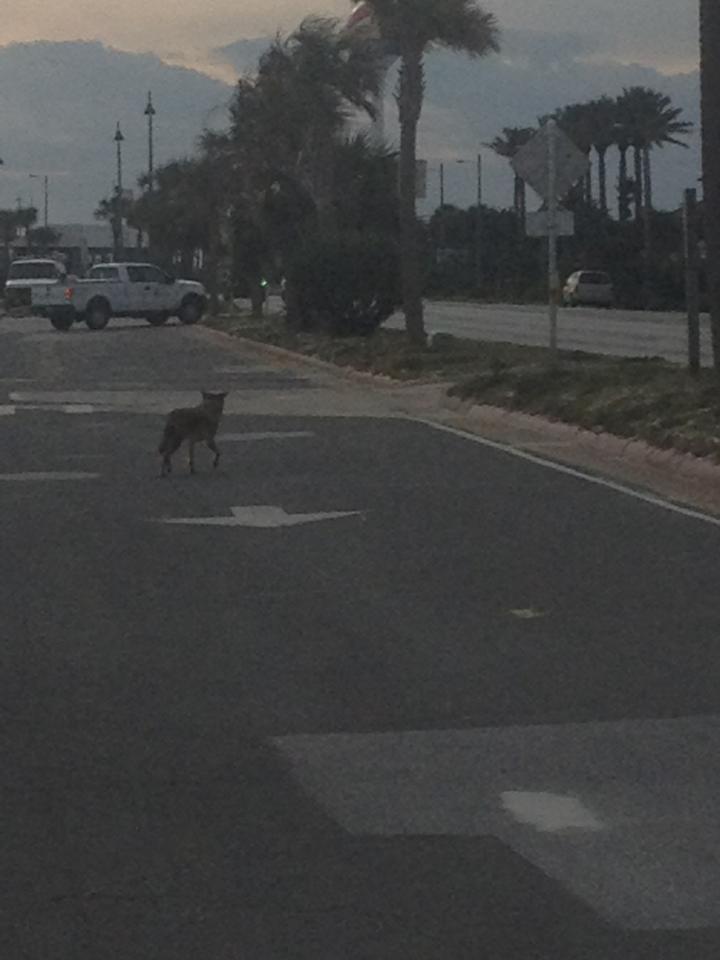
by Rick O'Connor | Oct 21, 2020
It’s Halloween…
The time of year we think of werewolves, warlocks, witches, and full moon evenings. But there is another creature who likes to howl at the moon this time of year – the coyote.
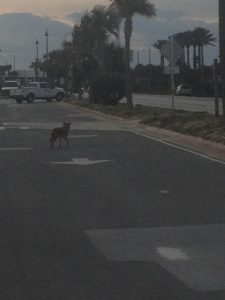
A coyote moving on Pensacola Beach near dawn.
Photo provided by Shelley Johnson.
Actually, coyotes howl all throughout the year, and they are not specifically howling at the moon. The name “coyote” is a Native American term meaning “singing dog”, or “barking dog”. They are famous for their early evening and early morning calls. Howls, barks, yelps, and yaps are very familiar to those living out west – and now for those living in the eastern United States.
It is believed the animal originated in the grasslands and deserts of the American southwest feeding on a variety of rodents. They have successfully dispersed across the country and can now be found in almost any habitat in the continental United States – including barrier islands. Though they owe much of their success to their ability to adapt to different foods and habitats, they also owe some of their success to humans. We have reduced their primary predators – bears, wolves, and mountain lions – to a level where they could move around more safely. There have been efforts to restore these predator populations in some localized areas of the U.S., but those are localized, and the process has been slow. All the while the coyote has enjoyed a more predator free world.
They are also opportunistic feeders. Though the bulk of their diet are small rodents, they are known to eat small birds, reptiles, amphibians, rabbits, squirrels, and even fruit. Out west, working in teams, they can take down larger prey – such as deer, and can do so here in the east as well. But their large prey targets are usually smaller members of the herd, sick, or old ones. They have also learned to feed on road kills of these animals.
Then there are humans. We provide an abundance of garbage which they have learned to scavenge through. Pet food left outside, gardens with produce, small livestock, and even pet cats and small dogs have been added to their menu. We have made their world much better.
With their numbers increasing in human populated areas, like Santa Rosa Island, people are becoming a bit nervous around them. The image of the toothed predator howling at the harvest moon on Halloween night in a pack with others makes us a bit uneasy. So, how dangerous are they?
Not very.
Coyotes are intelligent animals, and though they have learned to live and hunt within our neighborhoods, they are still afraid of us – they consider us trouble. On a recent trip to Colorado I was hiking down a trail and saw what appeared to be two sets of pointed ears in the grass. My guess was coyote but was not sure – so I began to walk towards them. Three coyotes immediately got up and moved off across the next ridge. They wanted nothing to do with me. And that is how it should be.
Those on barrier islands, like Santa Rosa, are no different. They are more active at dawn and dusk (crepuscular) and spend their days and late nights in a den somewhere. Occasionally people will see them in the middle of the day, or hear a yelp or howl around 2:00 AM, but it is more of a sunrise and sunset deal for them. They can remain motionless and undetected when people are around and will often run if we get too close. Many are not sure whether they are seeing a coyote or a German shepherd when they see one, both being about the same size. Coyotes tend to run with their tails down, unlike dogs and wolves who prefer to run with their tails up.
All of this said, there have been attacks on people – mostly out west and in southern California in particular. In most cases, the animals have either intentionally or unintentionally been fed by people. When this happens, they lose their fear of us and return for another easy meal. They are wild animals and being cornered by people or dogs (intentionally or unintentionally) can lead to defensive behaviors that could include attacks. To avoid this, we should not approach any coyote. Keep your trash secured and in cans that would be difficult for coyotes to access. Bring your pet food in at night and do not let pet cats and small dogs out in the evenings without supervision.
Bad encounters with these howling animals are rare, and with a little education and behavior changes on our part, should remain so.
Happy Halloween.
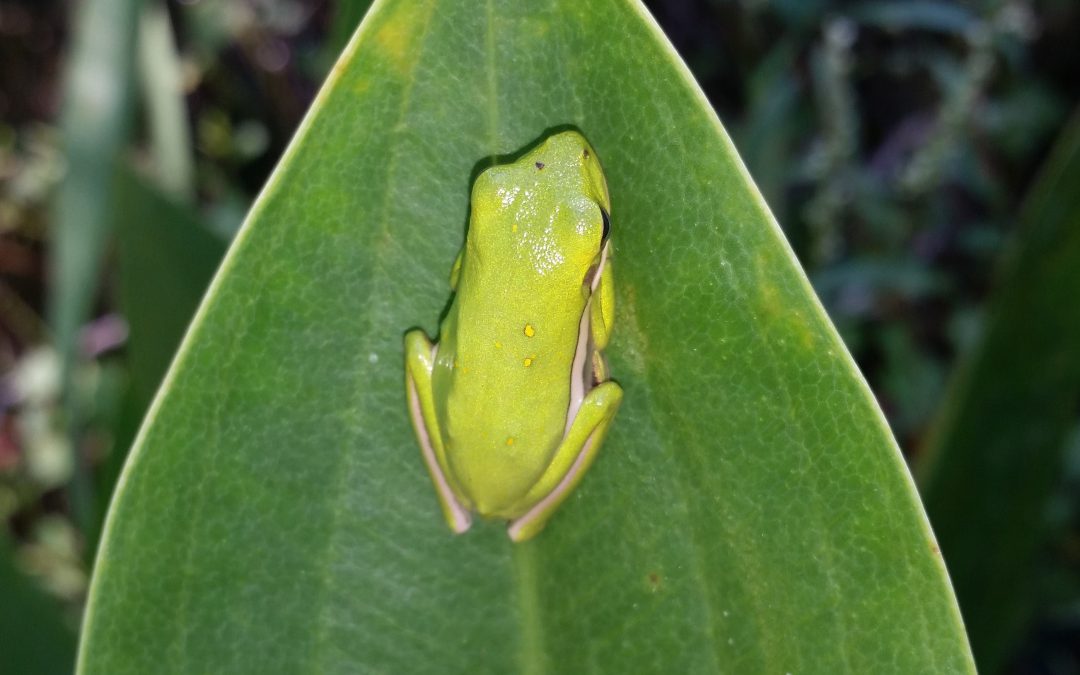
by Erik Lovestrand | Jun 4, 2020
WOW… is all I can say, when I step outside at night of late and become immersed in the spectacular chorus of calls from breeding frogs and toads near my Wakulla County residence. The sound reverberates to the level where it sometimes feels like it is echoing inside one’s head. Recent heavy rains have awakened local species to the notion that there is no time like the present for pro-creation; given the fact that many of the shallow, depressional wetlands in our region will only contain water for a short window of time.
This may seem like a drawback to the life style of frogs and toads that depend on these wetlands but nature has a way of surprising us with incredible adaptations for survival. For instance, the eastern spadefoot toad (Scaphiopus holbrookii) can actually survive through several years with no water available for raising their young. They do this by remaining buried in the ground, only emerging after heavy rains that collect in depressions. Tadpoles metamorphose into small toads within 28 days so by the time the pool goes dry they are likely long-gone. Female spadefoots will lay over 2,000 eggs at a time so the number of progeny that can emerge from a small depressional wetland is phenomenal. I recall seeing black stains across roadways all over the County about a month after one of our tropical storms. Baby spadefoot toads were dispersing by the millions from hundreds of shallow pools across the region and local roadways were one of the hazards they faced on their journey.
Another advantage to amphibians breeding in ephemeral (temporary) wetlands has to do with the fact that there are no fish to prey on the tadpoles. This is not a requirement for all species, as some have chemical defenses (bad taste) that limit predation, but others could not successfully breed in permanent bodies of water.
Some of the species I have heard calling lately include squirrel treefrogs, green treefrogs, Cope’s gray treefrogs, southern toads, cricket frogs, and a few others I have not identified yet. If you have never made an effort to identify the night calls of frogs and toads, you don’t know what you are missing in your local environment. Some are quite difficult to separate but many of very distinct and once you put the call with a name you won’t ever forget it. Take a moment to listen to one of my favorites, the southern toad; the origin of a beautiful, high-pitched trill that you most likely have never paid much attention to. This website (The Frog Blog) is a great resource to learn more calls. Be sure to listen also to the southern cricket frog call that sounds like two marbles clacked together, and Copes’ gray treefrog, which many might mistake for a bird as they call from high in the tree canopy.
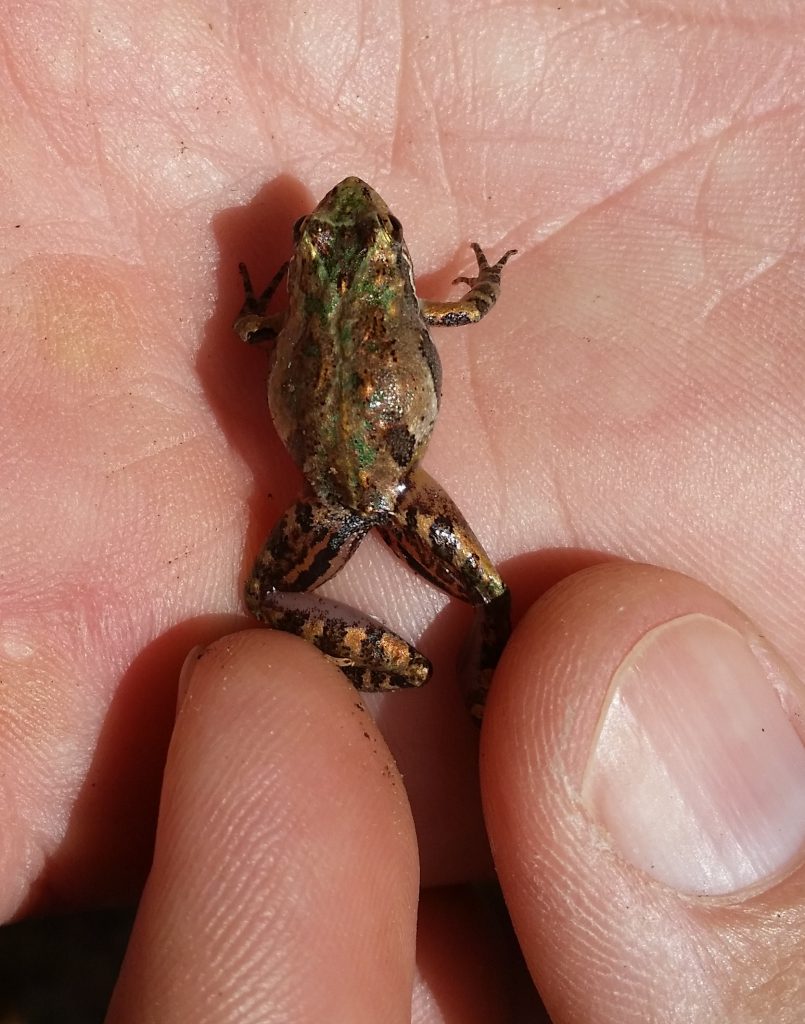
Cricket frogs are one of the smallest vertebrates on the planet.
The cacophony of sounds on a warm summer’s night can seem chaotic and random but if you spend a little time sorting out the musicians, you are sure to develop a deeper appreciation of the symphony, along with a better understanding of the well-orchestrated cycles of nature in your Panhandle backyard.
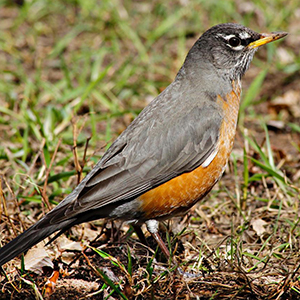
by Sheila Dunning | Dec 13, 2019
 As the migratory birds stop off or stay in the Panhandle this winter, they need to find food, food and more food. There is a wide variety of migration activity in Florida beginning in the fall months of September, October, and November. From woodland song birds to waterfowl to the annual warbler invasion, so many different species show up in Florida. While year-to-year migration patterns and winter foraging grounds can shift for some species due to a variety of reasons, some birds stay in Florida for the winter months of December, January, and February. Some may arrive early and others may stay late.
As the migratory birds stop off or stay in the Panhandle this winter, they need to find food, food and more food. There is a wide variety of migration activity in Florida beginning in the fall months of September, October, and November. From woodland song birds to waterfowl to the annual warbler invasion, so many different species show up in Florida. While year-to-year migration patterns and winter foraging grounds can shift for some species due to a variety of reasons, some birds stay in Florida for the winter months of December, January, and February. Some may arrive early and others may stay late.
Some North American breeding birds endure harsh winters; however, they are physically suited for cold environments in a number of ways. One, they are able to drop their metabolic rate to a near comatose state using very little energy. Two, they are able to position their feathers, or puff up, to trap heat generated by their own body. Others need to head to warmer climates.
Birds migrate for two reasons. Food and weather avoidance. North American breeding birds who nest in the northern part of the continent will migrate south for the winter. As winter approaches, insect and plant life diminishes in the snow-covered states. Migrating birds head south in search of food. Places like Florida are rich in insects, plant life, and nesting grounds.
Birds need high energy food to stay warm. Berry and seed producing plants contain proteins, sugars and lots of fats. Many native trees, shrubs and grasses can aid migratory and winter visiting birds in their relentless search for food. Gardening for birds and other wildlife enables an opportunity for people to experience animals up close, which providing an important habitat in the urban environment.
For more information on which plants are preferred by specific bird species go to: https://www.audubon.org/native-plants
For more information on landscaping for wildlife refer to: https://edis.ifas.ufl.edu/pdffiles/UW/UW17500.pdf
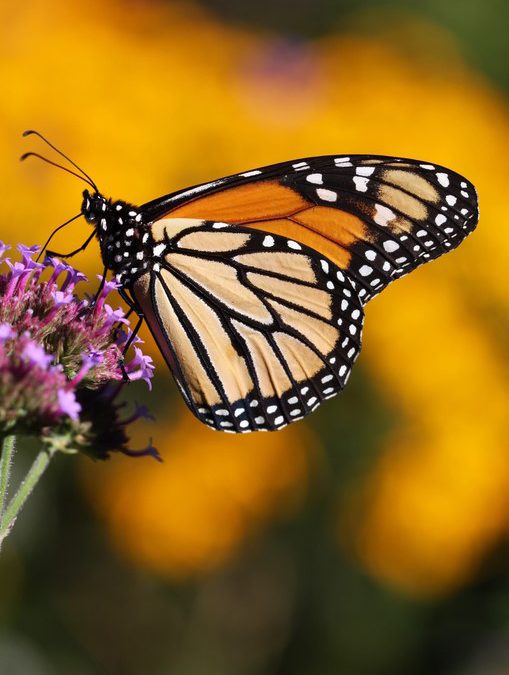
by Molly Jameson | Apr 18, 2019
With spring upon us, the mighty monarch butterflies have begun their long trek to the north from Mexico, looking to time their migration with growth of the milkweed plants in the southeastern United States. Mated monarch females lay hundreds of eggs along their journey, but only two percent of these eggs will survive to become mature caterpillars to carry on the next generation.
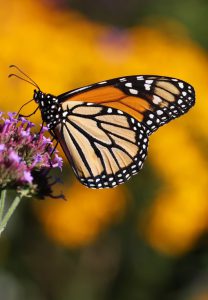
The monarch butterfly.
Photo: Steven Katovich USDA Forest Service
Monarch larvae rely exclusively on milkweed for nutrients, so it is of upmost importance that the plants are available to the offspring at the correct time. If the adult monarchs arrive too early, the milkweeds may not have had enough time to grow after late frosts. If they arrive too late, the milkweed vegetation may not support the nutrient needs of the caterpillars. In addition, the milkweeds contain a poisonous toxin, cardiac glycoside, that stays within the caterpillars’ bodies once consumed. This does not harm the larvae, but actually helps them, as it makes the young and adult butterflies taste terrible and makes them poisonous to potential predators.
For these reasons, it is important that we all do our part to support the growth of native milkweed species. Locally, the Monarch Milkweed Initiate at the St. Marks National Wildlife Refuge educates the public about milkweed and monarchs and grows and transplants native milkweed to support the monarchs on their migration.
When planting milkweed, be aware that there is a popular commercialized non-native tropical milkweed species that is not appropriate for the monarchs in our area. This species, Asclepias curassavica, can flower year-round, luring the monarchs to stay and breed in the winter when they should be on their way back to Mexico to escape freezing temperatures. Staying and breeding too long can make the monarchs susceptible to a protozoan parasite, Ophryocystis elektroscirrha (OE for short), that infects the caterpillars when feeding, reducing their lifespan, body mass, mating success rate, and ability to migrate.
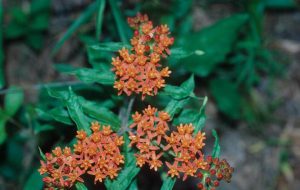
Butterfly milkweed (Asclepias tuberosa)
Photo: John Ruter, University of Georgia
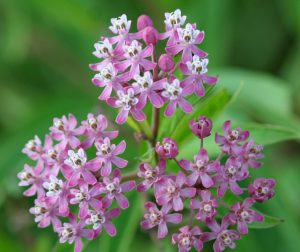
Swamp milkweed (Asclepias incarnata).
Photo: David Cappaert
Luckily, there are about 21 native milkweed species in Florida. Many native milkweeds in the Florida Panhandle require specialized care when grown for transplanting, as different species have adapted to a range of habitats. The Asclepias tuberosa, commonly referred to as butterflyweed, is considered easiest to grow as they transplant well and thrive in full sun. Others, such as Asclepias perennis, or aquatic milkweed, and Asclepias incarnata, swamp milkweed, must be grown using trays without drain holes, as their “feet” must be kept wet. The Asclepias humistrata, or sandhill milkweed, requires a drier, heavier soil.
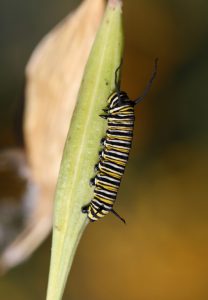
Monarch catepillar (Danaus plexippus).
Photo: Steven Katovich, USDA Forest Service
To support the monarchs and grow milkweed in your garden, come to the Leon County Extension Office at 615 Paul Russell Road on Saturday, May 11, from 9:00 a.m. to 1:00 p.m. for the Spring Open House and Plant Sale. Master Gardeners have been busy growing native milkweeds for this event and will be on hand selling the transplants. There will also be many other Florida Friendly and native plants available, along with guided garden tours, kids’ activities, the UF/IFAS Bookstore, a silent auction, live music by the Tallahassee Woodwind Quintet, refreshments, and Master Gardeners and Extension Agents on-hand to answer any of your gardening questions.
















